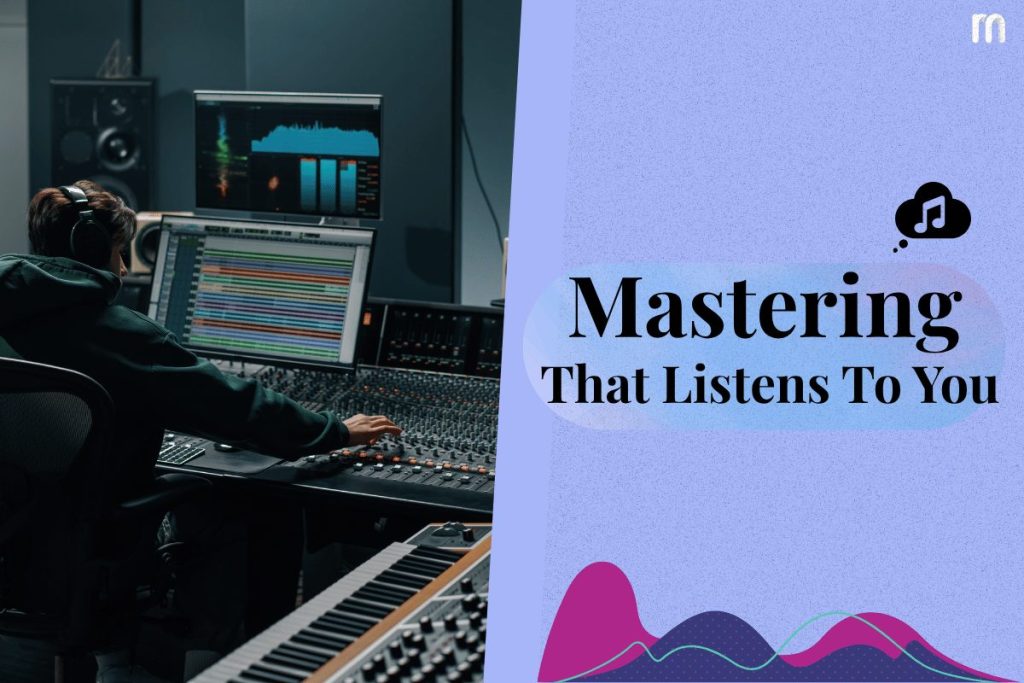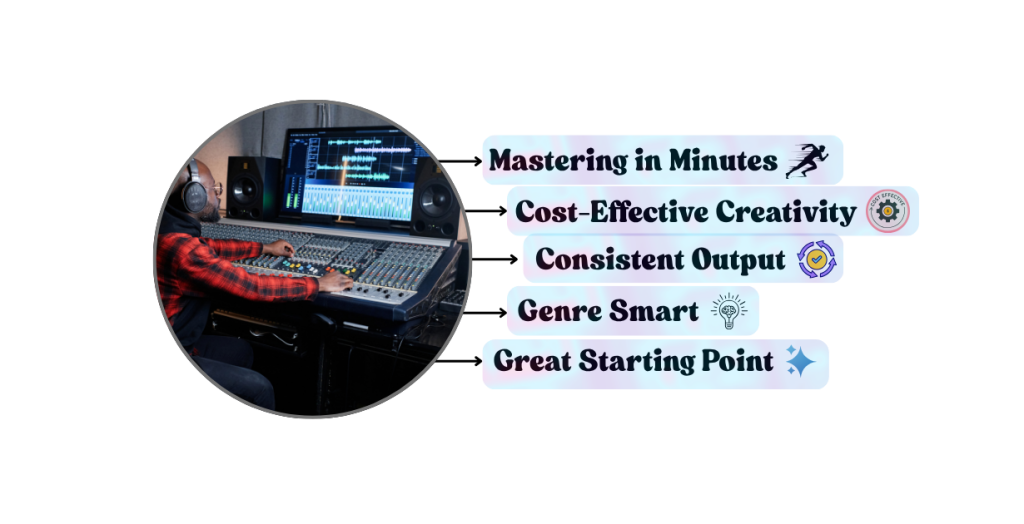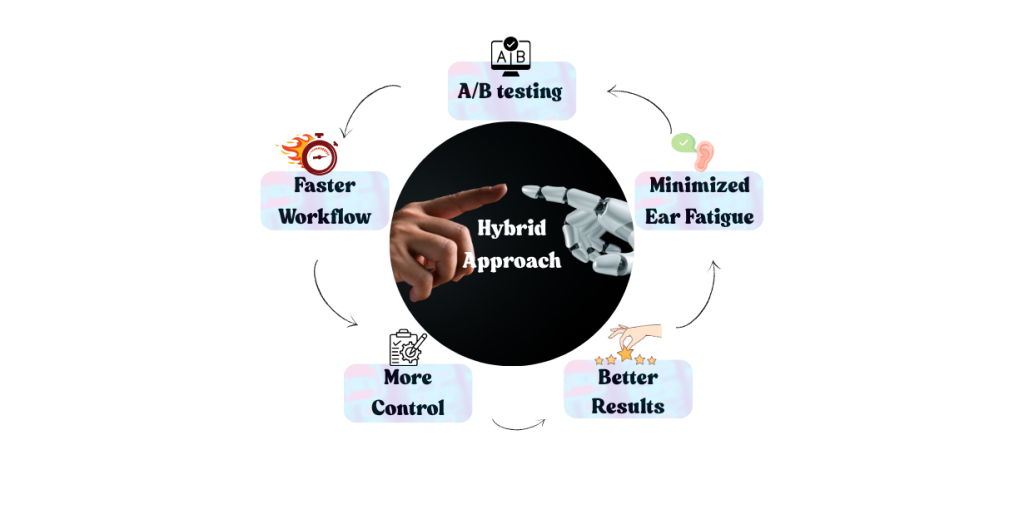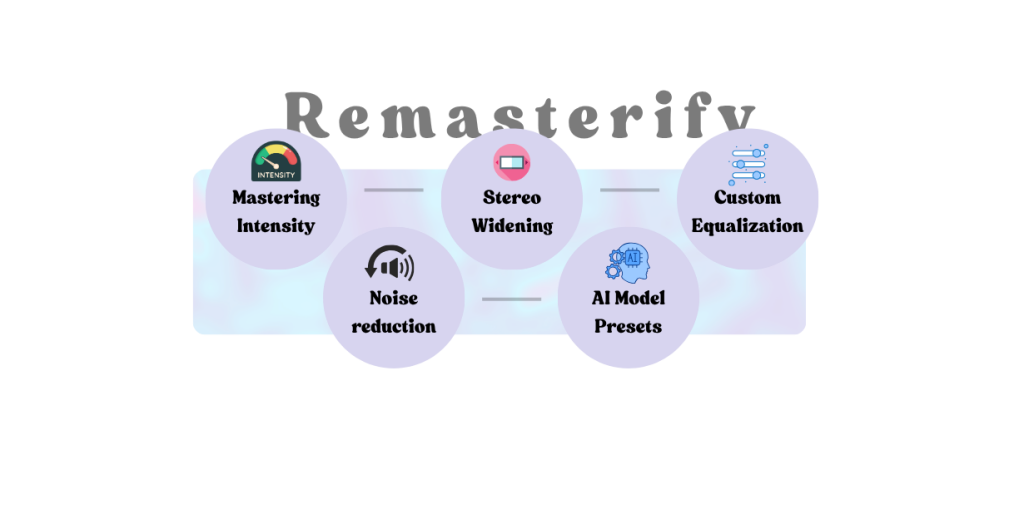Artificial Intelligence has made its way into almost every field. The music industry is one of them. With just a laptop and some plugins, anyone can make a track from their bedroom. And now with AI, even professional mastering feels like something you can automate in seconds.

But here’s the thing.
Professional mastering is a craft. It’s done by engineers who’ve spent years refining their ears, learning how to bring out the best in every mix. Unlike AI, they understand sound not just technically, but with creative intent. They bring artistic interpretation that AI simply can’t replicate.
So, in this blog, we’ll explore why professional mastering still matters, what AI brings to the table, and how the two can actually work together. And if you’re wondering which tools fit into all this—we’ll get there too.
Table of Contents
The Anatomy of Professional Mastering
AI Enters the Studio: Efficient, But not Expressive
A Hybrid Music Mastering Workflow
Example of a Hybrid Workflow Tool
Section 1: The Anatomy of Professional Mastering
From Analog Tape to Vinyl to Digital
Before mastering became a digital task you could do with a few clicks, it was a craft shaped by hands, ears, and years of experience. Back in the day, mastering engineers were known as transfer engineers. Their job? To carefully move audio from analog tape onto vinyl without losing sound quality or damaging the grooves.
That process wasn’t just technical. It was an art. Engineers learned how to shape the tone, clean up the mix, and make sure everything sounded smooth across speakers, jukeboxes, or record players.
As technology moved from vinyl to CDs to streaming, the tools changed. But the mission stayed the same: to create a professional sound that feels balanced, rich, and ready for every sound source.
That’s the root of professional mastering. Both science and soul working together.
What does it take to achieve Professional Audio Mastering?
Let’s clear something up. Professional sound is not about being loud. Neither is it about firing up the best music mastering software. In simplest words, it’s about balance, emotion, and clarity. It’s the kind of sound that feels complete—the kind that stands out on streaming platforms, radio, or even your car speakers.
A well-mastered song is carefully shaped to bring out the energy of the song without overdoing it. It keeps vocals clear, drums punchy, and instruments sitting right where they belong. A Professional sound helps translate the feel of a song, whether it’s warmth, tension, or joy. Read more to learn how to achieve a professional sound.
This is what separates good mastering from great mastering.
Real life Mastering Stories
Engineers make subtle yet impactful decisions that elevate a track. Here are insights from three esteemed professionals in the field:
Bib Ludwig, one of the most respected names in the industry, puts it beautifully:
“I always say that the secret of being a great mastering engineer is being able to hear a raw tape and then in your mind hear what it could sound like, and then knowing what knobs to move to make it sound that way.”
This quote shows how pro audio mastering isn’t just about tools, it’s about vision. Ludwig listens beyond the current sound. He imagines what it could sound, and then carefully shapes it to reach that goal. That’s the heart of professional mastering—not guesswork, but purposeful transformation.
Colin Leonard, who has worked with artists like Beyoncé and Justin Bieber, highlights how the landscape has changed:
“It’s definitely improved. The good stuff now sounds great. Part of that is technology, part is people learning more. Some stuff is loud, but that’s always going to be the case.”
Leonard touches on a big truth: with better tools and more knowledge, high-end mastering is now more accessible than ever. But even with louder and cleaner mixes, there’s still a difference between a solid track and a professional master. That difference often comes down to experience and the ability to push a song just a little further than most can hear.
These stories aren’t just about famous names. They’re a reminder that professional audio mastering is still rooted in human judgment, creative decision-making, and years of trained listening.
Section 2: AI Enters the Studio: Efficient, But not Expressive
AI Algorithms in Processing Audio
AI has started to make serious moves in the music world, especially in mastering. What used to be handled by the trained ears of seasoned engineers is now being tackled, in part, by code. But let’s break down what’s really happening behind the scenes.
Machine learning models
Modern AI mastering tools don’t just slap on a preset and call it a day. They use machine learning models trained on thousands of professionally mastered tracks. These models study patterns—like how bass is treated in hip-hop or how brightness is handled in acoustic songs—and apply those learnings to new tracks. The more they process, the more they refine their instincts.
Adaptative processors
Then there’s the inclusion of adaptive processors like dynamic EQs and multi-band compressors. While not strictly AI, they act smart. They react in real time to the signal—automatically adjusting based on how your audio evolves. This adds a layer of responsiveness that works well with AI-driven engines.
Reference-based
Another clever feature some AI tools now offer is reference-based mastering. This allows you to upload a professionally mastered track that you admire, and the algorithm will try to match your audio’s tonal and dynamic characteristics to that reference. It’s a useful shortcut for those still learning how to sound professional. Especially, when you know what you want your track to feel like but aren’t sure how to get there technically.
But here’s the thing: AI knows patterns, not emotions. It can replicate what’s worked before, but it doesn’t tailor the sound specifically to your music. It doesn’t know why your vocal needs to float or why your bass needs to punch harder in the second chorus.
What AI-based Mastering Does Well?

AI-based mastering brings some real advantages to the table, especially for independent artists or producers.
Speedy Results
AI tools can deliver a polished master in seconds. No waiting for revisions. No back-and-forth emails. Just upload your mix, pick a style or intensity, and you’ve got a usable track almost instantly. For demos, quick releases or testing different versions, it’s a game changer.
Budget Friendly
Hiring professional mastering engineers can be costly. If you’re just starting out or working on a small project, AI gives you access to good mastering at a fraction of the price. You don’t need to know EQ curves, loudness targets, or stereo imaging. The tool handles all of that for you.
Consistent Output
AI doesn’t get tired. It doesn’t have off-days or second-guess itself. That means when you’re mastering multiple tracks like for an EP or album, AI can give you consistent loudness and tonal balance across all of them.
Genre Smart
Many platforms include genre-based presets or reference-matching features. If you upload a favourite track, the AI will attempt to match its tone, loudness, and vibe. It’s not perfect, but it gets surprisingly close, especially for genres like EDM, pop, or lo-fi.
Great Starting Point
Even if you plan to send your music to professional mastering engineers later, AI can help you get the track 80% there. It’s a great way to test how your mix holds up when mastered. Think of it like a sketch before the final painting.
So yes, AI might not “feel” your music the way a human can. But it can definitely speed things up, keep costs down, and help you move forward with confidence. Learn how AI-based mastering revolutionizing.
Core Aspects Missing From AI-based Mastering
AI can master audio but it doesn’t understand music. That’s the key difference. While it’s great at identifying patterns and applying presets, here’s what it still can’t do:
Lack of Emotional Context
AI doesn’t feel your song. It can’t tell if a vocal is supposed to sound intimate or powerful. It doesn’t get shifts in tonalities that reflect an artist’s vision for the track.
No Understanding of Artistic Vision
Mastering engineers make decisions based on the story of a song. Maybe the chorus needs to explode, or the bridge needs more space. AI doesn’t understand what you’re trying to say—it just tries to make it “fit.”
Limited Genre Sensitivity
AI can struggle with genre-blending tracks. It might treat your lo-fi hip-hop/folk hybrid like straight-up pop. A professional audio mastering engineer, on the other hand, adjusts in real time—based on context, not code
No Feedback Loop
With a human, you can give feedback: “Can we make it warmer?” “Can we bring the vocals forward?” AI doesn’t take notes and gives you one version and hopes it works.
Lack of Creative Risk-Taking
Sometimes, professional mastering isn’t about “doing it right.” It’s about breaking rules in the right way. AI plays it safe. A seasoned mastering engineer knows when to bend the rules for something bold and unforgettable.
This is where human expertise truly shines. While AI can assist, it still can’t replicate the instincts, empathy, and judgment that go into pro audio mastering.
Professional Mastering Still Outshines AI
Where AI follows patterns, human engineers follow the creative intent. They listen deeply, make artistic choices, and adjust details based on genre, message, and feel. A mastering engineer knows when to preserve space, when to add punch, and when to break the rules for impact.
More importantly, a professional master isn’t just about sounding good—it’s about sounding right for the artist, the audience, and the context.
This is the kind of judgment AI still can’t replicate. And it’s exactly why, even today, pro audio mastering continues to be the gold standard for anyone serious about their sound.
Section 3: A Hybrid Music Mastering Workflow
Industry Adaptation
As AI continues to grow, the music industry isn’t choosing between humans and machines. It’s starting to combine them. More and more artists, engineers, and studios are embracing a hybrid mastering workflow that blends professional mastering techniques with AI-powered efficiency.
How Pros Are Using AI Today
Professional engineers aren’t afraid of AI, they’re using it as a tool. Some rely on AI for the early stages: like quick test masters or first drafts for clients. It speeds up the process, especially when working with tight deadlines or multiple versions of a mix.
Studios Are Getting Smarter
Big-name studios and indie engineers alike are integrating AI-assisted plugins into their setups. Tools like iZotope Ozone 11 or Mastering the Mix’s suite offer intelligent suggestions—not replacements, but starting points that save time.
Not a Replacement—A Puzzle Piece
The industry isn’t ditching humans. Instead, it’s using AI as an extra hand in the mastering chain. The final polish—the judgment, the emotion, the detail—is still done by humans. But AI helps get there faster and smoother.
More Access, Better Results
For independent artists who can’t always afford a mastering engineer, AI tools offer a way to get closer to that professional sound. And when paired with even basic human feedback or tweaks, the results can be surprisingly polished.
Bottom line? The industry isn’t stuck in the past, but it’s not rushing toward full automation either. It’s finding a balance—the best of both worlds.
Benefits of Hybrid Approach

Blending human expertise with AI-powered tools isn’t just about convenience. It’s also technically smarter. The hybrid approach allows artists and engineers to get the best of both worlds: precision, speed, and creativity working together.
Faster Workflow
AI can handle time-consuming tasks like loudness normalization, spectral balancing, and initial EQ suggestions. This allows engineers to spend more time on creative decisions, like fine-tuning emotional dynamics or enhancing sonic space.
More Control
With AI handling foundational mastering steps, engineers can dig deeper into advanced adjustments like mid-side EQ balancing, stereo field enhancement, and transparent limiting. Without having to getting bogged down in basic setup.
Opportunity to A/B testing in no time
AI-based tools allow for rapid generation of multiple mastering versions. Engineers can quickly compare tonal profiles, adjust intensity levels, and test different outputs. All without rendering delays.
Minimized Ear Fatigue
Listening to the same track for hours can wear down even the best engineers. AI can reduce repetitive tasks, helping engineers stay fresh for the fine-detail work where professional mastering truly shines.
In short, the hybrid model uses AI for what it’s good at—speed and precision—while reserving the final artistic and technical judgment for human ears.
How Engineers Are Integrating AI Into Mastering
More mastering engineers are no longer treating AI as competition. They’re using it as now a creative and technical partner. Whether it’s for early mastering passes, reference matching, or immersive sound design, AI is becoming part of the modern mastering toolkit.
Carlos Freitas: Building the Future with AI
Carlos Freitas, founder of Classic Master and co-founder of Spatial9, is a pioneer in using AI for immersive audio. His company is exploring how AI can create realistic, 3D soundscapes for VR, gaming, and interactive experiences.
Instead of relying on traditional stereo mastering alone, Freitas is pushing mastering into new territories—where spatial audio and AI-driven algorithms meet. It’s a sign that even seasoned engineers are embracing technology to enhance creative potential rather than replace it. Read More.
Shawn Everett: AI as a Creative Tool
Shawn Everett, celebrated for his Grammy-winning work with artists such as The War on Drugs and Kacey Musgraves, sees AI as a new kind of instrument.
He uses AI tools to test melodic and structural ideas, and he’s open about experimenting with automated processing in production and mastering. For him, AI isn’t a shortcut, it’s a creative jumpstart, allowing producers to generate options faster and explore directions they may not have considered on their own. Read More.
Section 4: Example of a Hybrid Workflow Tool
Redefining Professional Mastering for the Modern Creator
AI tools are everywhere now. But in music, especially in mastering, the question isn’t – “Can AI do it?.” It’s – “Can AI help you do it better?”
That’s where Remasterify comes in.
Instead of offering a one-click fix like many online mastering platforms, Remasterify is built on a different idea: you stay in control, while AI handles the heavy lifting. It’s a hybrid tool designed for artists, producers, and creators who care about sound—not just speed.
What makes it special is that it doesn’t treat mastering as a generic task. It treats it as aprofessional process that just happens to be smarter and faster. It gives you tools to shape your sound, refine details, and make sure your track reflects your original intent.
In a world of presets and instant outputs, Remasterify puts creative decisions back in your hands—right where they belong.
Remasterify’s Finetuning Capabilities

Remasterify stands out as one of the best online mastering tools—not just because it uses advanced AI, but because it lets you stay in control. While the AI handles the heavy lifting, Remasterify gives you powerful customization options to fine-tune your master based on your track’s unique needs.
Here’s how you can dial in your perfect master with Remasterify:
Choose Your AI Mastering Model
Pick how the AI behaves, depending on the feel you’re aiming for:
- AudioREM AI – Default
- Clean, natural, and spacious
- 44.1kHz | Very High Dynamic Range | Very Low Energy
- Great for acoustic, jazz, classical, and cinematic styles
- AudioREM AI – SHWSFO
- Modern, punchy, and forward
- 44.1kHz | Mid Dynamic Range | High Energy
- Perfect for pop, EDM, hip-hop, and energetic electronic genres
- Upload a Reference Track
- Got a pro song you love the master of?
- Upload it, and Remasterify will match the tonal and dynamic profile for you
- This is professional mastering with inspiration built in
Mastering Intensity
Control the loudness and compression:
- Ranges from Lowest to Highest
- Go subtle for natural feel—or intense for that commercial polish
- Helpful for making your track sit just right on streaming platforms
Stereo Widening
Shape the width of your mix:
- Options: Narrow, Standard, Wide, Wider, Widest
- Adds dimension and space without losing focus
- Essential for vocals, synths, and atmospheric tracks
Noise Reduction
Clean up background artifacts without killing vibe:
- Choose between five levels—from gentle to aggressive
- Especially useful for vocals, live instruments, or bedroom recordings
- Keeps your mix clean without sounding over-processed
Custom Equalization
Tweak the tonal balance to match your personal taste:
- Brighten the highs, warm up the lows, or soften harsh mids
- Gives you full control over clarity and character
- Ideal for polishing a mix that’s already 90% there
With these controls, Remasterify doesn’t just deliver good mastering. It helps you create a professional master that reflects your intent. It’s built for artists who care about how to sound professional without needing years of technical training. You don’t need to be a mastering engineer—you just need to know what you want to hear.
In Summary
Professional mastering still matters. It brings musical vision to life that AI alone can’t replicate. But AI isn’t here to replace—it’s here to assist.
Remasterify proves that with the right tools, artists can blend speed and control. Its AI-powered engine delivers fast results, while its customizable features let you shape your sound with intention.
This hybrid approach means more creators can achieve a professional master without compromise. You don’t need to choose between precision and creativity—you can have both.
Because in the end, mastering isn’t just technical—it’s what makes your music feel finished.
